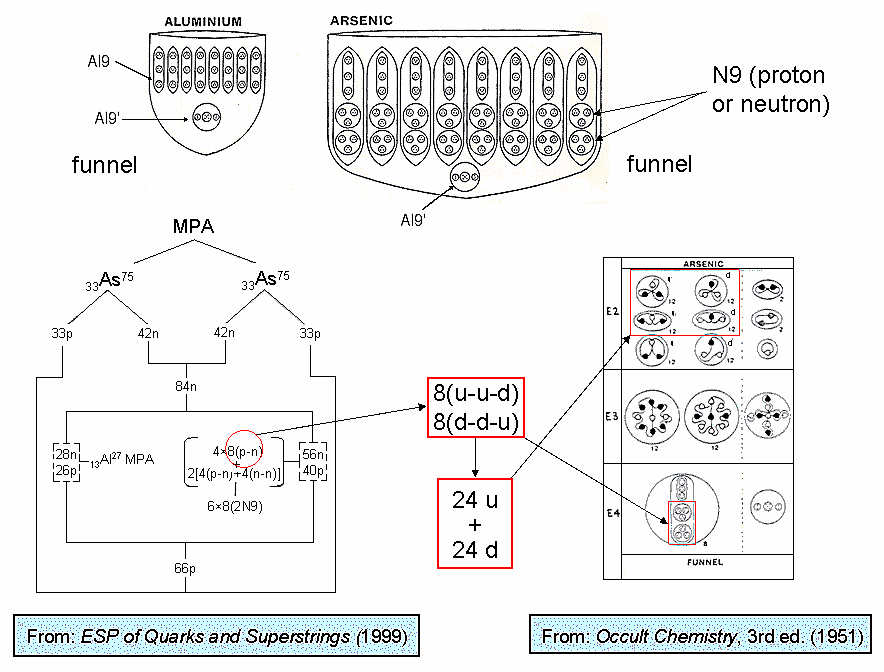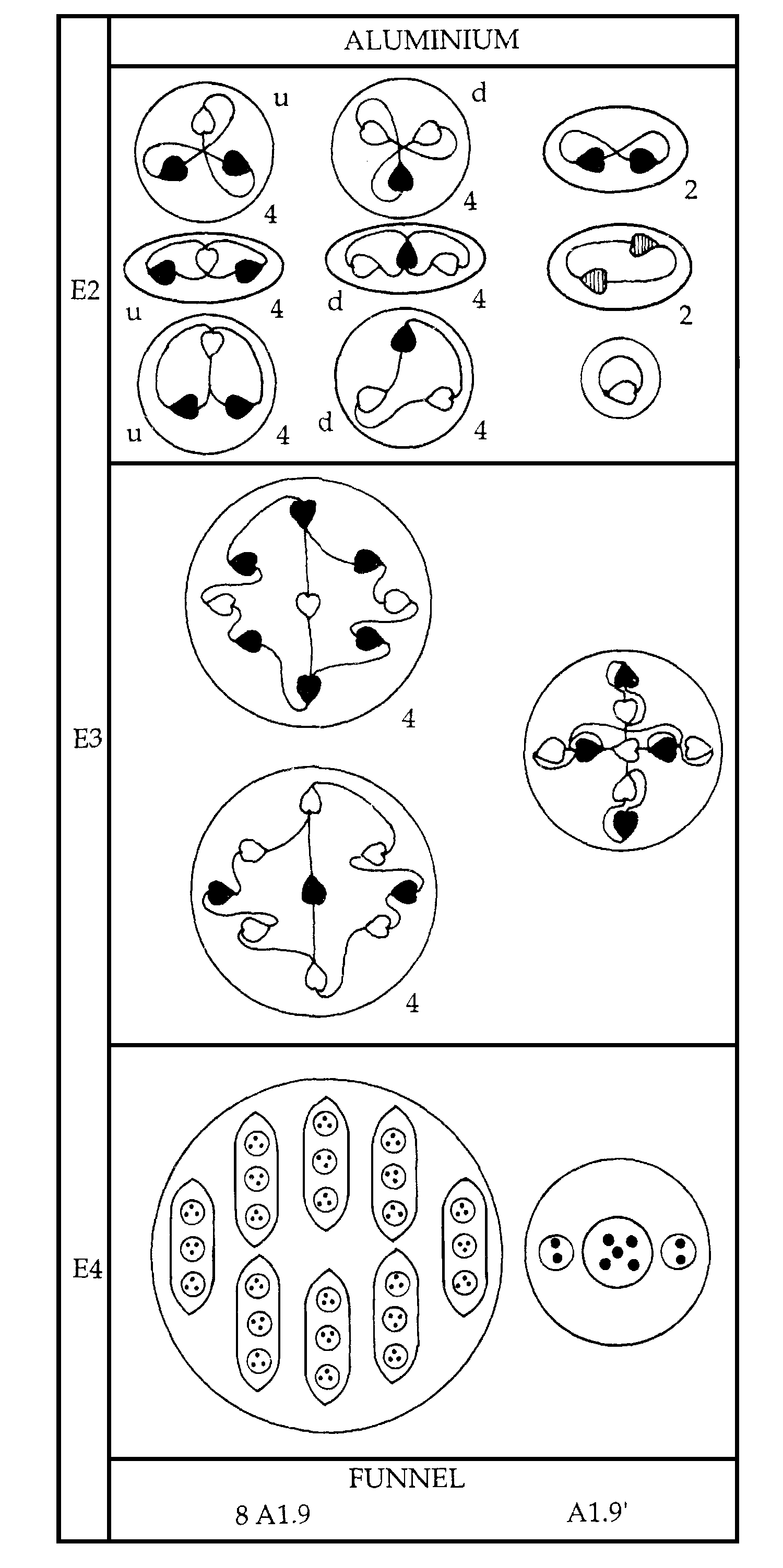
| << Previous 1... 6 7 [8] 9 10 ...13 Next >> |
The arsenic
MPA
MPAs are formed from two atomic nuclei of an element.* Clear evidence of this is provided by the arsenic MPA. It is a face-centred cubic array of six similar funnels. Each funnel contains an Al9′ group and eight segments, each of which contains an Al9 group and two spheres enclosing N9 groups, the Al9 and Al9′ groups being found in the aluminium MPA. The Al9′ is made up of three spheres, two enclosing a pair of UPAs and the third enclosing a group of five UPAs. The Al9 consists of three hydrogen triplets. The composition of the arsenic MPA is:
arsenic MPA = 6[Al9′ + 8(2N9 + Al9)].

This MPA is formed from two As75 nuclei, which provide 1350 subquarks — exactly the same as the number of counted UPAs. It differs from the aluminium MPA solely by having sixteen N9 groups in each funnel, i.e., by having ninety-six groups in total. Since analysis of the nitrogen MPA shows that an N9 is a neutron and since analysis of the chlorine MPA shows that it can be a proton, the arsenic MPA should contain ninety-six nucleons as well as the particles that belong to the aluminium MPA. The two As75 nuclei forming the MPA contain forty more protons and fifty-six more neutrons than the two Al27 nuclei that form an aluminium MPA, i.e., ninety-six more nucleons. This MPA therefore provides clear proof that the MPA of an element is formed from two of its atomic nuclei. It also demonstrates the remarkable consistency between nuclear physics and the composition of different MPAs recorded in 1908 in volume 29 of The Theosophist twenty-four years before the neutron was discovered!
Four funnels each contain eight pairs of N9 groups consisting of a proton and a neutron (as established by analyses of the nitrogen and chlorine MPAs). Each of the other funnels contain four pairs of N9 groups consisting of a proton and a neutron and four pairs consisting of two neutrons.
 The Al9 groups in each funnel consist of four u-u-u bound states and four d-d-d bound states.
Four of the funnels each contain twenty-four u quarks and twenty-four d quarks present in the eight protons
and eight neutrons that constitute the sixteen N9 groups There are therefore thirty-six u quarks and
thirty-six d quarks in each funnel. The diagram depicting the break-up of the particles in the arsenic MPA
provides spectacular support for this prediction because it shows that thirty-six (+) triplets (u quarks) and
thirty-six (-) triplets (d quarks) are released from the Al9 and N9 groups. Moreover, the fact that eight
segments of particles form twelve (+) and twelve (-) bodies is very significant for the following reason:
according to the diagram depicting the break-up of particles in the aluminium MPA (see opposite), eight Al9
groups change into four (+) and four (-) bodies of the same kind. Since four (+) bodies break up into twelve
(+) triplets (u quarks) and four (-) bodies break up into twelve (-) triplets (d quarks), according this
diagram, it follows that
The Al9 groups in each funnel consist of four u-u-u bound states and four d-d-d bound states.
Four of the funnels each contain twenty-four u quarks and twenty-four d quarks present in the eight protons
and eight neutrons that constitute the sixteen N9 groups There are therefore thirty-six u quarks and
thirty-six d quarks in each funnel. The diagram depicting the break-up of the particles in the arsenic MPA
provides spectacular support for this prediction because it shows that thirty-six (+) triplets (u quarks) and
thirty-six (-) triplets (d quarks) are released from the Al9 and N9 groups. Moreover, the fact that eight
segments of particles form twelve (+) and twelve (-) bodies is very significant for the following reason:
according to the diagram depicting the break-up of particles in the aluminium MPA (see opposite), eight Al9
groups change into four (+) and four (-) bodies of the same kind. Since four (+) bodies break up into twelve
(+) triplets (u quarks) and four (-) bodies break up into twelve (-) triplets (d quarks), according this
diagram, it follows that
8(2N9) = 24u + 24d,
i.e.,
2N9 = 3u + 3d,
which is consistent with one N9 group being a proton (u-u-d) and the other being a neutron (u-d-d).
Discussion of other issues raised by the analysis of the arsenic MPA are discussed in ESP of Quarks and Superstrings (p. 191).
*Groups of UPAs were labelled according to the number of UPAs found in them and the element in whose MPA it was first observed. For example, if a bound state of N UPAs was first noticed in the element with chemical symbol X, it would be called the "XN group." For example, the H3 triplets observed in the MPA of hydrogen with chemical symbol H consist of three UPAs.
| << Previous 1... 6 7 [8] 9 10 ...13 Next >> |